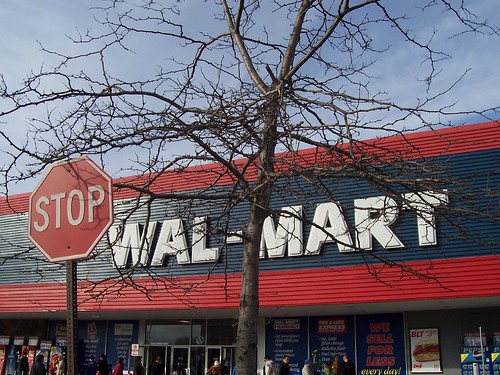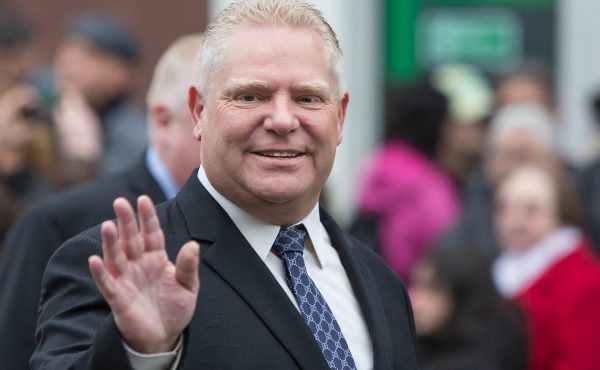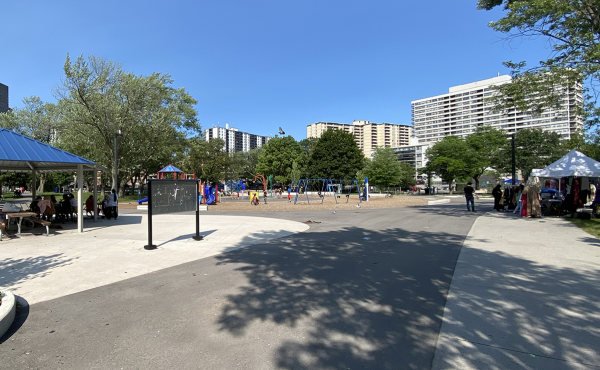
Early this afternoon, the OMB sided with the City of Toronto and against the big box proposals in Leslieville. The City sent out the following press release at 3:45:
The City of Toronto successfully defended its Official Plan policies today as the Ontario Municipal Board upheld the City’s right to maintain the area South of Eastern Avenue as an Employment District without large format, stand alone retail outlets.
“Preserving and protecting employment lands is an important part of Toronto’s Official Plan,” said Mayor David Miller. “This decision recognizes that position and strengthens our ability to ensure Toronto can prosper now and in the future.”
“The OMB decision has found that the test to add large format stand-alone retail to employment districts is a difficult one to meet,” said Brendan O’Callaghan of the City’s legal division.
The OMB found that the functioning of other economic activities within this district would have been undermined if the Smart Centres application had been approved.
And from an article by Dave Nickle at InsideToronto.com:
Last year the developer, SmartCentres, squared off with the city and the community at the Ontario Municipal Board. The marathon hearing carried on through spring, summer and fall of 2008. The decision, originally expected before Christmas, arrived just Wednesday afternoon.
The 56-page decision lambasted city planners and local councillor Paula Fletcher for politically-motivated planning decisions. But in the end, board vice-chair James McKenzie ruled the retail complex would contaminate the east-end employment district, opening the door for other viable employment uses to convert their properties into retail, and that existing city plans for the area effectively blocked the redevelopment.
Also check out the Toronto Star’s article.
photo by Lone Primate




35 comments
Provincial policy (Growth Plan for the Greater Golden Horseshoe) is pretty clear in this regard… not a big surprise that this was the decision rendered.
Unexpected but amazing! Also, absolutely love the photo. Great find.
From one who lives in the area, it’s a great relief to dozens of small businesses who’ve been fighting this for years.
This decision has made many small business people in the area very happy. This allows us to keep the charter of this area alive. We don’t need these big box stores and their desire to take over,with hopes of closing us down.Thank you and good night.
Fantastic News, a boost for all communities with large vacant industrial sites or farmlands facing the prospect of big box. Author Stacey Mitchel wrote the following summary regarding the costs of big box chains – useful overview. http://www.startribune.com/opinion/commentary/25631274.html?location_refer=Opinion
HOLY FREAKING COW!!!
WOOOOHOOOOO!
Queen East really will be the new Queen West. Rock on! Party at the Dark Horse tonight!
Sweet! Walkable, Bikeable, Lovable Community-based Sweetness!
Very good and surprising news.
Great News!
Does this mean that box-based community planning is finally over the hill?
This is great, minimum wage small stores selling Chinese crap are far superior to minimum wage big ones like WalMart.
Everyone emphasizes the anti-Wal-mart angle, but I’m hoping that the decision will explain in detail why large-scale retail is bad *planning*, maybe this will finally get some people to see beyond the
short-term loss of quickly constructed retail premises and the quick job boost results that would give the city.
But the city may have to mix water with their wine, since the decision may well be portrayed as deliberately anti-development and anti-business. Those labels will stick on Miller, Fletcher & Co.
(those notorious NDPers!), and they may have to throw the business community (and the provincial government) a bone or two–some sort of quickie non-retail development that can be spun as “intelligent”, “forward looking”, bla-bla-bla. I hope they don’t, but money has a loud voice.
This has been a long and hard fight and I am thrilled that this is the result. Congrats to all those who participated in this process!
Devils advocate here:
Currently Lake Shore Blvd east of the DVP is very car oriented and is more like a suburban parkway than an urban arterial. Along this stretch includes a Canadian Tire and grocery stores with large parking lots, to name a few. Even though there is ample space for a light rail ROW (especially since there is already abandoned rail in the middle of the boulevard), not even infrequent bus service runs along this stretch, requiring people to head north to Queen and then back down if they want to travel this corridor.
This is also not a small town either. There are approximately 200,000 people living between the DVP, Danforth, and Victoria Park. For North American standards, that is extremely high density and I am confident the local economies of Queen East could survive with a Wal Mart nearby; Especially since smaller downtown shopping districts far less densely populated have done so. And with the recession in full gear, chasing out one of Canada’s largest employers from investing in your community may not be the best decision.
In conclusion, if they are not going to allow a Wal Mart, fine. But do SOMETHING with the land along the Lake Shore, or AT LEAST run a bus along there every 20 minutes or so.
The OMB misplace their rubber stamp?!
We need to see what eventually goes on this site, then we can decide if this was a victory or not. Only blocks from here are a whole whack of box stores and nobody seemed to complain about those, in fact locals flock to them. I find this curious.
Anyone have a link to the omb decision?
I doubt it. Smart Centres will find a field somewhere to plant a Wal-Mart somewhere.
There are plenty of factories to knock down in this city for a big box retail.
It’s a positive first sign, but one will have to wait what will happen with the land. Our commercial tax rate isn’t the most business friendly, but the City has some new initiatives to improve competitiveness.
When the decision is available, it will be posted here:
http://www.omb.gov.on.ca/ecs/CaseDetail.aspx?n=PL051314
It will be posted under today’s date.
I too think this is not about being anti-Walmart (though some on the ground along Queen East may have expressed themselves as such) but rather a victory for good land use. If a Walmart wants to go in, and fit themselves in appropriately, so be it. As Ben above says, 200,000 people is a massive population, and good stores should be able to compete alright (notwithstanding whatever loss-leader and bulk buying practices Walmart engages in).
But based on voting records — this is the deepest, darkest, thickest NDP-land of them all — if indie businesses are going to survive somewhere, it’ll be here. If they can’t, then the inner city behaves exactly like the 905, and 416 snobbery should be something we never endure again. If the population that most vocally is anti-big-box still goes to big-box and indie stores fail, then, well, that’s simply what people want.
When it’s looked at as a good land use victory, the anti-development charges’ ammunition is diminished considerably: come, Walmart, if you want, but behave in a civilized way.
Interesting how everyone loves the OMB today.
The rail line in the boulevard on Lake Shore is NOT abandoned. It connects all the way down to Unwin Ave and there is occasional switching activity.
So many people claim to be anti-Wal-Mart but their stores are always busy. The fact is that they do have good prices on many things, and people will go shopping there for fresh grocery products at good prices and many other things that well-priced. Indie stores will thrive when they offer what Wal-Mart does not sell. That’s what makes a neighbourhood commercial district successful, not propping up stores that sell the same merchandise for twice the price.
Shawn,
You make a good point about that being the area where if small business’s can’t survive, then that portends to larger issues. It has nothing to do with the city behaving like the 905 though.
Again I ask you and Spacing readers to consider the plight that was to befall Duke’s Cycle. Taxes were going to kill them if the fire had not got to them first ( http://southofsteeles.blogspot.com/2008/04/death-by-fire-then-death-by-taxes.html ).
Having area;s declared “Employment Lands” is not enough. The stark reality is that the city is more than 1/4 of a million jobs behind its own estimates. The city needs more than a decree. It needs to fix the tax mess now.
Shawn> your idea that indie business have a better chance of survival in “NDP areas” is conjecture. There are lots off strips of vibrant indie business in non-NDP areas. Remember, the problem with people is that they generalize too much. : )
I worked at Toronto Film Studios and have many NDP/left leaning friends in the area and was surprised how many wanted a Wal Mart so things are a bit more nuanced than we all would like them to be. It is also interesting how many people were against the WalMart but shop 4 blocks away at the other car-centric box stores. I bet if the store was going to be an Ikea, and I think that is a possibility, most people would have been for it.Personally I dont shop at Wal Mart, but I do shop at box stores AND indie stores and I vote NDP sometimes and Liberal sometimes.
scottd> That’s very interesting — to imagine what the debate in Leslieville would have been like if it was an Ikea rather than Walmart. Maybe the same, maybe…….
At any rate, that too is one reason the victory should be framed around good land use rather than a particular store. A victory for the Official Plan.
People love Ikea, it what Eatons was to my parents, even if they have to drive to it often much further than driving to other box stores.
Lets see if Ikea tries to move there.
I think Shawn nailed it when he described as a “land use” victory.
I live in the area and for me it was about a “Smart Centre” style mall and whether that fit into the shape and flow of the Toronto we wanted to support.
For me the comparison was the Smart Centre on Laird Ave. just south of Eglinton. It went in on similar industrial land just east of somewhat dense residential, mostly houses but also small apartments and seniors homes. From an urban texture point of view I think it’s a big problem. It’s totally car-centric to the point where a shopper would have to drive between mid-sized big boxes on one side to get to the mid-sized big box on the other. There are similar parking lot in the centre, large outlets on the edge malls on Eglinton west of Warden on the Golden Mile that are equally troublesome. These centres change traffic flow dramatically and change the character of the parts of town they inhabit.
I think this part of town warrants more granular development, not less.
Finally, I’m glad to see this decided as a civic decision rather than a purely commerical decision. As we’re seeing in other quarters, market dynamics do not always favour real people.
If you haven’t already read the StarTribune link above or see any of the anti-big box films that are out there. They clarify the actual impact of these types of centres on place and people.
full text of the OMB’s decision:
http://www.omb.gov.on.ca/e-decisions/pl051314-mar-03-2009.pdf
Glen > if taxes are so smothering in Toronto, why are there so many thriving independent businesses? Why can so many businesses prosper in this environment? There seem to be so many exceptions to your rule, that I think the rule might be wrong.
Case in point, my neighbourhood bike accessory store Velotique just sent out this postcard announcing their retirement and their interest in selling the business. They’ve even creating a site detailing how their business has worked, and prospered:
http://www.velotique.com/forsale
City tax policy should certainly be up for debate, but I don’t see it as dire.
Mark,
Velotique is not selling a building but a business. Again I refer to the Dukes example on my blog. While Duke’s will carry on, it will not do so in the old location.
There is a circular relationship between tax and value. Value determines taxes and taxes determine value. You can clearly see this at play when multi residential properties are reclassified as residential. The average market value for an apartment in the multi residential class is ~$68,000. The mere stroke of a pen can increase that market value to by a factor of 2 to 3. This is in actual market value. What a willing buyer would pay a willing seller.
Why this has relevance to ’employment lands, is simply that the tax burden on non residential properties is so high as to discourage investment. Look at the reports done on behalf of the city of Toronto by Hemson Consulting. One of the comparisons in the report is that of constructing a new office building in Toronto compared to Mississauga. Even though the land cost 55% more in Mississauga (which in itself is indicative of fundamental problems) it is economically unfeasible to build such a office in Toronto while it is in Mississauga. Also it shows that even though Toronto commercial property tax rate is 59% higher, by means of devaluing the assessment, the city only generates 2% more tax revenue. All the while it misses out on the development and other charges which net the city a lot of revenue.
Of course there are going to be pathological exceptions, like office towers that need subway service. Or the ground-floor retail that appears in many condo’s. You should note though that most developers would not have any ground floor retail or commercial space but are forced to do so. The cost to build is the same, yet residential space fetches over $300 per sq.ft. while commercial frequently gets less than $150 per sq.ft.
So while there are many successful small businesses in the city, on the issue of tax and how it effects development, it is the landlords that pay the price. The amount Velotique or any other tenant is willing to pay for rent sets the upper bound on value. The city’s tax rate determines the distribution between itself and the the landlord. The balance of what remains determines the value.
Toronto has been labouring under the misconception that its higher commercial taxes translates into higher tax revenues. Having a rate that is twice as high as its neighbors has reduced values by half of what they should be. All the while making development outside of the city more desirable and profitable.
“Also it shows that even though Toronto commercial property tax rate is 59% higher, by means of devaluing the assessment, the city only generates 2% more tax revenue. ”
Does that mean Toronto’s commercial property tax is effectively only 2% higher than Mississauga’s?
It means that Toronto’s rate but not revenue is higher. Again there are a number of issues at play here. Some commercial space is subjected to the speculation of redevelopment into residential. Thus its assessment will be inflated (generating more tax for the city). There is also the issue of the CVA caps, which are a means to move older properties towards paying the new (market value assessment) rates over a period of time. So it is difficult to make direct comparisons across municipal boundaries.
I have gone over this issue with a few well know economist, concluding that using appreciation over time is a valid means in which to compare. That way you are really comparing a subject property with itself.
Similar to the land appreciate post on my blog….
If in 1986 one was to have spent $1,000,000 on industrial land in Mississauga today it would be worth over $4,000,000. By comparison if that money was spent in Toronto it would be worth on average today $1,800,000. Applying commercial tax rates on the current values would mean that Mississauga would receive $42,678.84 from that property (4,000,000 * 1.066971%). By comparison Toronto would receive 41,278.13 (1,800,000 * 2.2932294%).
Sounds like the answer to my question is yes.
Sorry for the lengthy answer Boris. I just wanted to spell it out so anyone reading it would not dismiss the difference was academic. At least not to the property owner who has lost nearly half of his/her property value.
I certainly agree that preserving and protecting employment lands is an important part of Toronto’s Official Plan. This is a great news for the locals.